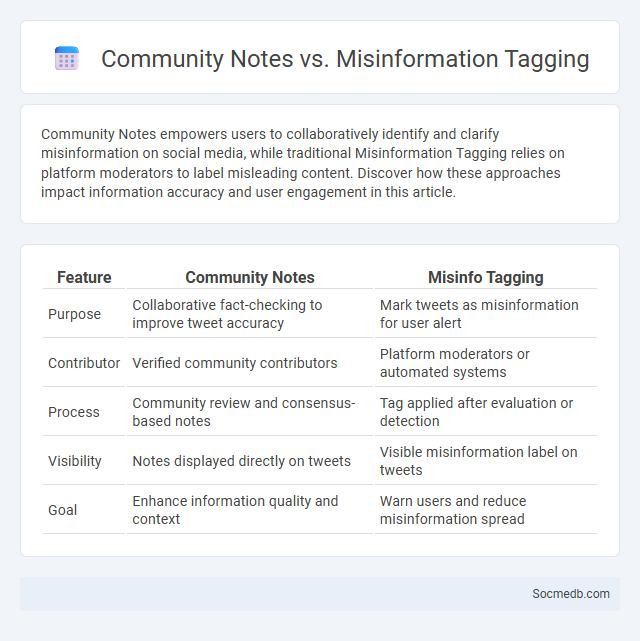
Photo illustration: Community Notes vs Misinformation Tagging
Community Notes empowers users to collaboratively identify and clarify misinformation on social media, while traditional Misinformation Tagging relies on platform moderators to label misleading content. Discover how these approaches impact information accuracy and user engagement in this article.
Table of Comparison
| Feature | Community Notes | Misinfo Tagging |
|---|---|---|
| Purpose | Collaborative fact-checking to improve tweet accuracy | Mark tweets as misinformation for user alert |
| Contributor | Verified community contributors | Platform moderators or automated systems |
| Process | Community review and consensus-based notes | Tag applied after evaluation or detection |
| Visibility | Notes displayed directly on tweets | Visible misinformation label on tweets |
| Goal | Enhance information quality and context | Warn users and reduce misinformation spread |
Understanding Community Notes: Definition and Purpose
Community Notes are user-generated annotations on social media platforms designed to provide context and factual information to posts, aiming to combat misinformation. These notes are collaboratively written and rated by a diverse group of contributors, ensuring accuracy and neutrality. By highlighting verified facts and refuting false claims, Community Notes enhance the credibility and reliability of social media content.
Misinformation Tagging: How It Works
Misinformation tagging on social media uses advanced algorithms and AI to identify and flag false or misleading content by analyzing patterns, keywords, and user reports. This process enables platforms to reduce the spread of harmful misinformation by attaching warning labels or fact-checking notes directly to posts. Your engagement with tagged content helps improve accuracy, ensuring a safer and more informed online community.
Key Differences Between Community Notes and Misinformation Tagging
Community Notes rely on collective user input to add context and improve content accuracy through transparent collaboration, while misinformation tagging is typically applied by platform moderators or algorithms to directly label false information. Community Notes promote user engagement and trust by offering a nuanced perspective without explicitly marking content as false, whereas misinformation tagging often results in warnings or content removal to prevent misinformation spread. Both approaches aim to enhance information integrity, but Community Notes encourage community-driven fact-checking, contrasting with the authoritative enforcement characteristic of misinformation tagging.
Effectiveness in Combating False Information
Social media platforms deploy advanced algorithms and AI-powered fact-checking tools to identify and reduce the spread of false information, significantly enhancing content credibility. Collaborations with independent fact-checkers and user reporting systems increase the accuracy of flagged content, ensuring timely interventions. These efforts contribute to a more informed online community by limiting misinformation reach and promoting verified sources.
User Engagement and Participation in Community Notes
User engagement in Community Notes thrives through active participation, where you can contribute insights that enhance content accuracy and credibility. By interacting with diverse perspectives, your involvement strengthens communal trust and fosters a more informed social media environment. Consistent contributions increase visibility and impact, motivating more users to join and support the platform's collaborative fact-checking efforts.
Transparency and Trust in Content Moderation
Transparency in social media content moderation involves clear communication about policies, decision-making processes, and the rationale behind removals or restrictions, fostering user trust. Platforms employing transparent moderation practices enhance accountability, reduce misinformation, and support community guidelines' fairness. Trust is strengthened when users understand how harmful or misleading content is identified and managed, promoting a safer digital environment.
Challenges Faced by Community Notes and Tagging Systems
Community Notes and tagging systems on social media face significant challenges in maintaining accuracy and preventing misinformation. Users often encounter difficulties with bias, inconsistent tagging, and the potential for manipulation by coordinated groups. The scalability of moderation efforts is strained by the vast volume of content, necessitating advanced algorithms and community-driven oversight to enhance reliability.
Impact on Social Media Discourse
Social media revolutionizes discourse by amplifying diverse voices and enabling real-time interaction, fostering dynamic conversations across global communities. Algorithms shape content visibility, often creating echo chambers that reinforce existing beliefs and influence public opinion. This digital environment transforms traditional communication patterns, promoting both increased engagement and challenges such as misinformation spread and polarized debates.
Case Studies: Success Stories and Failures
Case studies highlighting social media success stories demonstrate how brands like Nike and Starbucks boost engagement through strategic content and community building, resulting in increased sales and brand loyalty. Conversely, failures such as the Pepsi 2017 ad backlash show the critical need for cultural sensitivity and audience understanding to avoid negative public reaction. Your ability to analyze these real-world examples can guide effective social media strategies and prevent costly mistakes.
Future Trends in Community-Driven Fact-Checking
Future trends in community-driven fact-checking on social media emphasize the integration of artificial intelligence with human oversight, enhancing accuracy and scalability. Platforms increasingly leverage decentralized networks where users collaboratively verify information, promoting transparency and trust. Emerging tools utilize real-time data analytics and blockchain technology to track source credibility, reducing the spread of misinformation effectively.
 socmedb.com
socmedb.com